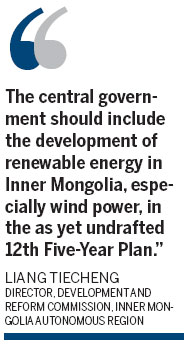Energy
Windy province seeks to sell nature's bounty
By Zhang Ran (China Daily)
Updated: 2010-05-17 09:16
 |
Large Medium Small |
BEIJING - As the country's No 1 in wind power resources and No 2 in solar power potential, nothing is more urgent for top policymakers in the Inner Mongolia autonomous region than promoting their new energy development strategy during the nation's 12th Five-Year Plan running from 2011 to 2015.
China was the world's largest wind energy market in 2009, more than doubling its wind farm capacity from 12.2 gigawatts (gW) in 2008 to 25.8 gW in 2009.
Inner Mongolia, one of China's seven "wind bases", has been leading the country in developing new energy, especially wind power, over the past five years. Its wind power capacity reached 7.3 gW as of the end of March, accounting for nearly one third of the total installed wind power across the country. That figure becomes more impressive when considering the capacity in the region stood at 170 megawatts in 2005, an increase of more than 4,000 percent in only five years.

Inner Mongolia's wind power amounts to 20 percent of its coal-fired thermal power, compared with 2 percent at national level. The region's estimated total wind power potential amounts to 150 gW, almost half of China's onshore wind power potential.
"The central government should include the development of renewable energy in Inner Mongolia, especially wind power, in the as yet undrafted 12th Five-Year Plan," said Liang Tiecheng, director of the Development and Reform Commission of Inner Mongolia Autonomous Region in an interview with China Business Weekly.
"Only by making it a national-level strategy, putting forward national renewable energy targets, priority sectors, and policies and measures for implementation, can the wind power capacity in the region be totally realized," said Liang.
According to the official, the region's new five-year development plan sets forth investment in and construction of wind power projects with a total installed capacity of 30 gW by 2015.
"The central government aims to reduce carbon emissions by 40 to 45 percent by 2020 and control and reduce pollution. Inner Mongolia is an indispensable part of this ambitious goal," said Wang Zhonghe, mayor of Chifeng, a city located in the northeast of Inner Mongolia and rich in wind resources and non-ferrous metals.
Liang and Wang, as representatives of the National People's Congress (NPC), have made great efforts to promote the region's wind power development, hoping it could be included in the country's 12th Five-Year plan during the annual NPC session held in March. Altogether, half of the proposals submitted by the Inner Mongolia representative team were focused on energy development.
"This is a priority for the economic development of Inner Mongolia," Liang said.
He added that Inner Mongolia's gross domestic product surged 16 percent year-on-year to 196.2 billion yuan in the first quarter of this year. Investment in new-energy industries such as wind power and polycrystalline silicon was 5.8 billion yuan, or about 23.5 percent of the total industrial investment.
However, the development of wind power in Inner Mongolia has met with a bottleneck.
| ||||
Inner Mongolia has more than 80 wind farms which have to cease production because of the inability to transmit their power outside its borders. Within the 55,000 sq km of land that makes up Ulanqab, where Li works there is a potential for 7,000 sq km of wind farms with a capacity of 33 gW of power.
The whole Ulanqab area had 2 gW of installed wind power, with 1.7 gW connected to the West Inner Mongolia grid, a lower level and local electric grid with limited connections with the State Grid that operates the nationwide grid.
"We hope the State Grid will bring the West Inner Mongolia grid to its network in the 12th Five-Year Plan," Li said. "The new five-year plan should also aim to speed up the construction of a smart grid to export the wind power produced by Inner Mongolia."
Development of the smart grid, which can send electricity a longer distance with less waste, compared with conventional power transmission technology, would solve the problem effectively.
The State Grid and the Inner Mongolia government reached a preliminary agreement last month to increase the connection with the West Inner Mongolia grid, indicating it will accept more power from this area for the rest of the country.
The country's electricity network operator also said recently that construction of ultra-high voltage power transmission lines accounted for most of its current work.
Sending electricity at a voltage, as high as 1,000 kV, these lines are said to be more energy-efficient compared with conventional lines.



